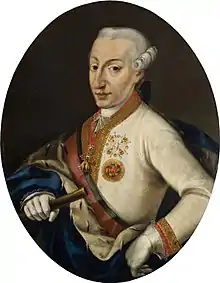Ercole III d'Este, Duke of Modena
Ercole III d'Este (Ercole Rinaldo; 22 November 1727 – 14 October 1803) was Duke of Modena and Reggio from 1780 to 1796, and later of Breisgau (not resident). He was a member of the House of Este.[1][2]
| Ercole III d'Este | |||||
|---|---|---|---|---|---|
 Portrait by Guzzaletti Gian Battista, 1780 | |||||
| Duke of Modena and Reggio | |||||
| Reign | 22 February 1780 – 7 May 1796 | ||||
| Predecessor | Francesco III d'Este | ||||
| Successor | Position abolished until 1814 Francis IV, Duke of Modena (House of Habsburg-Este) | ||||
| Born | 22 November 1727 Ducal Palace, Duchy of Modena and Reggio | ||||
| Died | 14 October 1803 (aged 75) Treviso, Duchy of Treviso | ||||
| Spouse | |||||
| Issue Detail | Maria Beatrice, Duchess of Massa | ||||
| |||||
| House | Este | ||||
| Father | Francesco III d'Este, Duke of Modena | ||||
| Mother | Charlotte Aglaé d'Orléans | ||||
| Religion | Roman Catholicism | ||||
Biography
He was born in Modena, the son of Duke Francesco III d'Este, Duke of Modena and Charlotte Aglaé d'Orléans, daughter of Philippe d'Orléans, Duke of Orléans and Regent of France. He was the couple's fourth child and had an older sister Maria Teresa and two brothers who died before his birth.[3]
In 1741, he married Maria Teresa Cybo-Malaspina, heir and, from 1780, sovereign of the Duchy of Massa and Carrara: their relations turned out to be extremely unhappy and the Duchess lived for most of the time in Reggio, separated from her husband. When his parents succeeded as rulers of Modena, he was styled His Royal Highness the Hereditary Prince of Modena (1737–1780) and after 1780, His Royal Highness the Duke of Modena.
Generally appreciated by his subjects (he sometimes spoke in Modenese dialect with them), and continued the reform begun by his father. He built the two bridges at Rubiera and St. Ambrogio at Modena on the Via Emilia, and built new roads connecting to the neighbouring states. In 1785 he founded the Atesine Academy of Fine Arts: during his reign arts and culture flourished, and among his protégées were Lazzaro Spallanzani, Giambattista Venturi, Girolamo Tiraboschi, Lodovico Ricci and others.
After the death of his wife in 1790, he married morganatically in 1795 with his long-time mistress Chiara Marini (d. Treviso, 1800), whom he invested with title of Marchioness of Scandiano (only formally, without any authentic rule over this land).[4]
The French invasion forced him to flee to Venice on 7 May 1796, carrying with him a conspicuous personal asset. Later French soldiers captured him at Venice, robbing 200,000 zecchini from his house. After this episode he moved to Treviso, where he died in 1803. The peaces of Treaty of Campo Formio (1797) and Lunéville had assigned him territories in Breisgau in exchange of the lost Duchy, but he never took possession of them.
His only legitimate daughter Maria Beatrice married Archduke Ferdinand of Austria. Their son Francis IV regained the Duchy of Modena and Reggio in 1814.
Issue
- Maria Beatrice d'Este (7 April 1750 – 14 November 1829), married Archduke Ferdinand of Austria and had issue.
- Rinaldo Francesco d'Este (4 January 1753 – 5 May 1753), died in infancy.
- Ercole Rinaldo (1770 – 16 February 1795), created Marquess of Scandiano in 1787, General in the Modena Army (died illegitimate, before the marriage of their parents).
Ancestry
Notes
- "Collections Online | British Museum". www.britishmuseum.org. Retrieved 2021-04-23.
- "Ercole d'Este, Duke of Modena III (1727-1803)..." www.findagrave.com. Retrieved 2021-04-23.
- "ERCOLE III d'Este, duca di Modena e Reggio in "Dizionario Biografico"". www.treccani.it (in Italian). Retrieved 2021-04-23.
- ESTE (di MONTECCHIO) Duchi di Modena e Reggio in genmarenostrum.com [retrieved 24 February 2015].
- Genealogie ascendante jusqu'au quatrieme degre inclusivement de tous les Rois et Princes de maisons souveraines de l'Europe actuellement vivans [Genealogy up to the fourth degree inclusive of all the Kings and Princes of sovereign houses of Europe currently living] (in French). Bourdeaux: Frederic Guillaume Birnstiel. 1768. p. 86.
External links
 Media related to Ercole III d'Este at Wikimedia Commons
Media related to Ercole III d'Este at Wikimedia Commons